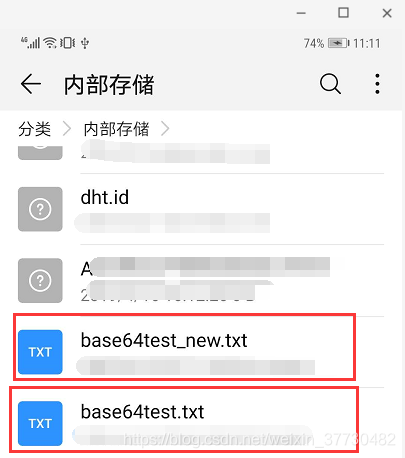
Base64加密解密
Base64加密解密。
一.简介
Base64是网络上最常见的用于传输8Bit字节代码的编码方式之一,Base64并不是安全领域的加密算法,其实Base64只能算是一个编码算法,对数据内容进行编码来适合传输。标准Base64编码解码无需额外信息即完全可逆,即使你自己自定义字符集设计一种类Base64的编码方式用于数据加密,在多数场景下也较容易破解。Base64编码本质上是一种将二进制数据转成文本数据的方案。对于非二进制数据,是先将其转换成二进制形式,然后每连续6比特(2的6次方=64)计算其十进制值,根据该值在A--Z,a--z,0--9,+,/ 这64个字符中找到对应的字符,最终得到一个文本字符串。基本规则如下几点:
1.标准Base64只有64个字符(英文大小写、数字和+、/)以及用作后缀等号。
2.Base64是把3个字节变成4个可打印字符,所以Base64编码后的字符串一定能被4整除(不算用作后缀的等号)。
3.等号一定用作后缀,且数目一定是0个、1个或2个。这是因为如果原文长度不能被3整除,Base64要在后面添加\0凑齐3n位。为了正确还原,添加了几个\0就加上几个等号。显然添加等号的数目只能是0、1或2。
4.严格来说Base64不能算是一种加密,只能说是编码转换。
二.常用详解
1.Bitmap转Base64
public static String bitmapToBase64(Bitmap bitmap) {
String result = "";
ByteArrayOutputStream bos = null;
try {
if (null != bitmap) {
bos = new ByteArrayOutputStream();
//将bitmap放入字节数组流中
bitmap.compress(Bitmap.CompressFormat.JPEG, 90, bos);
// 将bos流缓存在内存中的数据全部输出,清空缓存
bos.flush();
bos.close();
byte[] bitmapByte = bos.toByteArray();
result = Base64.encodeToString(bitmapByte, Base64.DEFAULT);
}
} catch (Exception e) {
e.printStackTrace();
} finally {
if (null != bos) {
try {
bos.close();
} catch (IOException e) {
e.printStackTrace();
}
}
}
return result;
}附:bitmap.compress(Bitmap.CompressFormat.JPEG, 90, bos);
这个是图像压缩的方法,三个参数分别是压缩后的图像的格式(png),图像显示的质量(0—100),100表示最高质量,图像处理的输出流(out)。
Bitmap.compress方法确实可以压缩图片,但压缩的是存储大小,即你放到disk上的大小。
2.Base64转Bitmap
public static Bitmap base64ToBitmap(String base64String) {
byte[] bytes = Base64.decode(base64String, Base64.DEFAULT);
Bitmap bitmap = BitmapFactory.decodeByteArray(bytes, 0, bytes.length);
return bitmap;
}3.字符串进行Base64编码
public static String stringToBase64(String string){
String encodedString = Base64.encodeToString(string.getBytes(), Base64.DEFAULT);
return encodedString;
}4.字符串进行Base64解码
public static String base64ToString(String string){
String decodedString =new String(Base64.decode(string,Base64.DEFAULT));
return decodedString;
}5.对文件进行Base64编码
public static String fileToBase64(File file){
String encodedString="";
FileInputStream inputFile = null;
try {
inputFile = new FileInputStream(file);
byte[] buffer = new byte[(int) file.length()];
inputFile.read(buffer);
inputFile.close();
encodedString = Base64.encodeToString(buffer, Base64.DEFAULT);
} catch (Exception e) {
e.printStackTrace();
}
return encodedString;
}6.对文件进行Base64解码
public static void base64ToFile(String string,File file){
FileOutputStream fos = null;
try {
byte[] decodeBytes = Base64.decode(string.getBytes(), Base64.DEFAULT);
fos = new FileOutputStream(file);
fos.write(decodeBytes);
fos.close();
} catch (Exception e) {
e.printStackTrace();
}
}7.整个工具类
package com.wjn.okhttpmvpdemo.mode.utils;
import android.graphics.Bitmap;
import android.graphics.BitmapFactory;
import android.util.Base64;
import java.io.ByteArrayOutputStream;
import java.io.File;
import java.io.FileInputStream;
import java.io.FileOutputStream;
import java.io.IOException;
/**
* Base64 加密解密 工具类
*/
public class Base64Utils {
/**
* Bitmap转Base64
* */
public static String bitmapToBase64(Bitmap bitmap) {
String result = "";
ByteArrayOutputStream bos = null;
try {
if (null != bitmap) {
bos = new ByteArrayOutputStream();
//将bitmap放入字节数组流中
bitmap.compress(Bitmap.CompressFormat.JPEG, 90, bos);
// 将bos流缓存在内存中的数据全部输出,清空缓存
bos.flush();
bos.close();
byte[] bitmapByte = bos.toByteArray();
result = Base64.encodeToString(bitmapByte, Base64.DEFAULT);
}
} catch (Exception e) {
e.printStackTrace();
} finally {
if (null != bos) {
try {
bos.close();
} catch (IOException e) {
e.printStackTrace();
}
}
}
return result;
}
/**
* Base64转Bitmap
* */
public static Bitmap base64ToBitmap(String base64String) {
byte[] bytes = Base64.decode(base64String, Base64.DEFAULT);
Bitmap bitmap = BitmapFactory.decodeByteArray(bytes, 0, bytes.length);
return bitmap;
}
/**
* 字符串进行Base64编码
* */
public static String stringToBase64(String string){
String encodedString = Base64.encodeToString(string.getBytes(), Base64.DEFAULT);
return encodedString;
}
/**
* 字符串进行Base64解码
* */
public static String base64ToString(String string){
String decodedString =new String(Base64.decode(string,Base64.DEFAULT));
return decodedString;
}
/**
* 对文件进行Base64编码
* */
public static String fileToBase64(File file){
String encodedString="";
FileInputStream inputFile = null;
try {
inputFile = new FileInputStream(file);
byte[] buffer = new byte[(int) file.length()];
inputFile.read(buffer);
inputFile.close();
encodedString = Base64.encodeToString(buffer, Base64.DEFAULT);
} catch (Exception e) {
e.printStackTrace();
}
return encodedString;
}
/**
* 对文件进行Base64解码
* */
public static void base64ToFile(String string,File file){
FileOutputStream fos = null;
try {
byte[] decodeBytes = Base64.decode(string.getBytes(), Base64.DEFAULT);
fos = new FileOutputStream(file);
fos.write(decodeBytes);
fos.close();
} catch (Exception e) {
e.printStackTrace();
}
}
}
8.调用
//Bitmap转Base64
Bitmap bitmap= BitmapFactory.decodeResource(getResources(),R.mipmap.zan);
String result= Base64Utils.bitmapToBase64(bitmap);
textView.setText(result);
//Base64转Bitmap
Bitmap bitmap1=Base64Utils.base64ToBitmap(result);
imageView.setImageBitmap(bitmap1);
//字符串使用Base64加密解密
String string="Base64加密解密......";
String encodedString = Base64Utils.stringToBase64(string);
String decodedString =Base64Utils.base64ToString(encodedString);
textView.setText("加密后:"+encodedString+"\n"+"解密后:"+decodedString);
//File转Base64
File file=new File("/storage/emulated/0/base64test.txt");
String string=Base64Utils.fileToBase64(file);
textView.setText(string);
//Base64转File
File newfile=new File("/storage/emulated/0/base64test_new.txt");
Base64Utils.base64ToFile(string,newfile);
9.针对Base64.DEFAULT参数说明
无论是编码还是解码都会有一个参数Flags,Android提供了以下几种
DEFAULT 这个参数是默认,使用默认的方法来加密
NO_PADDING 这个参数是略去加密字符串最后的”=”
NO_WRAP 这个参数意思是略去所有的换行符(设置后CRLF就没用了)
CRLF 这个参数看起来比较眼熟,它就是Win风格的换行符,意思就是使用CR LF这一对作为一行的结尾而不是Unix风格的LF
URL_SAFE 这个参数意思是加密时不使用对URL和文件名有特殊意义的字符来作为加密字符,具体就是以-和_取代+和/
10.总结
Base64编码看似简单,但是其在实际开发中使用相当广泛。目前项目中只是用到这么多,以后用到更复杂的情况的时候再做补充。
11.补充
使用Base64方式转换Bitmap与字符流时会涉及编码和解码
编码
String url="http://www.abc.com.8080:/abc/def/ghi/aaa.html?name=张三&age=30";
String encodeContent = null;
try {
encodeContent = URLEncoder.encode(url, "utf-8");
} catch (UnsupportedEncodingException e) {
e.printStackTrace();
}
Log.d("TAG", "encodeContent----:" + encodeContent);解码
String decodeContent = null;
try {
decodeContent = URLDecoder.decode(encodeContent, "utf-8");
} catch (UnsupportedEncodingException e) {
e.printStackTrace();
}
Log.d("TAG", "decodeContent----:" + decodeContent);结果
encodeContent----:http%3A%2F%2Fwww.abc.com.8080%3A%2Fabc%2Fdef%2Fghi%2Faaa.html%3Fname%3D%E5%BC%A0%E4%B8%89%26age%3D30
decodeContent----:http://www.abc.com.8080:/abc/def/ghi/aaa.html?name=张三&age=30更多推荐
 已为社区贡献3条内容
已为社区贡献3条内容









所有评论(0)